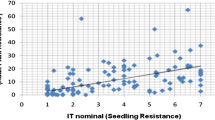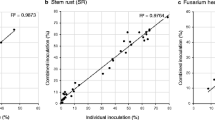Abstract
The need for a new analytical approach was encountered in the course of characterizing newly developed tomato lines resistant to late blight. Late blight resistant tomato lines were created in independent breeding programs using the accession Solanum pimpinellifolium L. (formerly Lycopersicon pimpinellifolium (L.) Miller) L3708 as the source of the resistance. However, initial field observation suggested that the late blight resistance in the lines produced by two independent breeding programs differed. Possible causes included a partial transfer of the late blight resistance derived from S. pimpinellifolium L3708 or the possibility of race specificity of this resistance. A crucial issue was determining the most appropriate and robust analytical method to use with data from laboratory analyses of the responses of nine tomato lines against five P. infestans isolates. Prior analysis by standard ANOVA revealed significant differences across tomato lines but could not determine whether the disease responses in the CLN-R lines were different from those of the heterozygous F1 hybrids, created by crossing susceptible tomatoes with the fixed CU-R lines. A different analytical method was needed. Therefore, sporangia numbers/leaflet and diseased area data were analyzed using a half-normal probability plot and regression analysis. The results of this analysis show its utility for genetic or pathology studies. Considering only populations of the uniform tomato lines, this method confirms the results obtained by using a standard ANOVA, but provides a clearer demonstration of the distributions of the individuals within the populations and how this distribution impacts variance and the difference among the populations. This method also allows a joint analysis of the uniform lines with an additional population that is less uniform, because it is segregating. Such an analysis would be invalid using a standard ANOVA. The results of this joint analysis determined that the additional population was divergent from the fixed CU-R lines, and, against some isolates, against the CLN-R lines as well. Half-normal probability plot analysis method would be applicable more broadly beyond analysis of disease resistance data. It could be useful for data from populations that are not normally distributed, for traits which are affected by epistatic gene action, and could be useful for selection of extremes.


Similar content being viewed by others
References
AVRDC (1994) 1993 Progress Report. Asian Vegetable Research and Development Center, Shanhua, Tainan, Taiwan, pp 201–203
Birnbaum A (1959) On the analysis of factorial experiments without replication. Technometrics 1:343–357
Castano J, Mackenzie DR, Nelson RR (1989) Components analysis of race non-specific resistance to blast disease of rice caused by Pyricularia-Oryzae. Phytopathology 127:89–99
Chunwongse J, Chunwongse C, Black L, Hanson P (2002) Molecular mapping of the Ph-3 gene for late blight resistance in tomato. Hort Sci Biotech 77:281–286
Daniel C (1959) Use of half-normal plots in interpreting factorial two-level experiments. Technometrics 1:311–342
El-Kharbotly A, Pereira A, Stiekema WJ, Jacobsen E (1996) Race specific resistance against Phytophthora infestans in potato is controlled by more genetic factors than only R-genes. Euphytica 90:331–336
Freialdenhoven A, Scherag B, Hollricher K, Collinge DB, Thordal CH, Schulze LP (1994) Nar-1 and Nar-2, two loci required for Mla-12-specified race-specific resistance to powdery mildew in barley. Plant Cell 6:983–994
Kim MJ (2003) Characterization of the late blight resistance of Lycopersicon pimpinellifolium accession L3708, and its transfer to elite processing tomato lines. Cornell University, Ph.D Thesis
Kim MJ, Mutschler MA (2005) Transfer to Processing Tomato and Characterization of Late Blight Resistance Derived from Solanum pimpinellifolium L3708. J Amer Soc Hort Sci (in press)
Krane SA (1963) Half-normal plots for multi-level factorial experiments. Proceedings of the eighth conference on the design of experiments in army research development and Testing. ARO-D Report 63-2. U.S. Army Research Office, Durham, pp 261–285
Kruger J, Thomas CM, Golstein C, Dixon MS, Smoker M, Tang S, Mulder L, Jones JDG (2002) A tomato cysteine protease required for Cf-2-dependent disease resistance and suppression of autonecrosis. Science 296:744–747
Legard DE, Lee TY, Fry WE (1995) Pathogenic specialization in Phytophthora infestans: aggressiveness on tomato. Phytopathology 85:1355–1361
Li ZK, Sanchez A, Angeles E, Singh S, Domingo J, Huang N, Khush GS (2001) Are the dominant and recessive plant disease resistance genes similar?: a case study of rice R genes and Xanthomonas oryzae pv. oryzae races. Genetics 159:757–765
Pan Q, Wang L, Ikehashi H, Tanisaka T (1996) Identification of a new blast resistance gene in the indica rice cultivar Kasalath using Japanese differential cultivars and isozyme markers. Phytopathology 86:1071–1075
Rao KK, Lakshminarasu M, Jena KK (2002) DNA markers and marker-assisted breeding for durable resistance to bacterial blight disease in rice. Biotech Adv 20:33–47
Acknowledgements
We would like to thank Dr. Bill Fry (Department of Plant Pathology, Cornell University) for providing pathogen isolates and for advice on pathogen maintenance and use and Edward D. Cobb (Department of Plant Breeding, Cornell University) for assistance in plant growth. We would also like to thank Drs. Hanson and Black of the AVRDC, Tainan Taiwan, for generously supplying seeds of their tomato lines, and for cooperative discussions on the differences among late blight resistant lines. We also thank the person who reviewed this manuscript in July 2005 for the clarifying comments provided. This work was supported by Hatch Project 149484 and gifts from the California League of Tomato Processors.
Author information
Authors and Affiliations
Corresponding author
Additional information
Communicated by H. C. Becker
Rights and permissions
About this article
Cite this article
Kim, MJ., Federer, W. & Mutschler, M.A. Using half-normal probability plot and regression analysis to differentiate complex traits: differentiating disease response of multigenic resistance and susceptibility in tomatoes to multiple pathogen isolates. Theor Appl Genet 112, 21–29 (2005). https://doi.org/10.1007/s00122-005-0084-2
Received:
Accepted:
Published:
Issue Date:
DOI: https://doi.org/10.1007/s00122-005-0084-2




